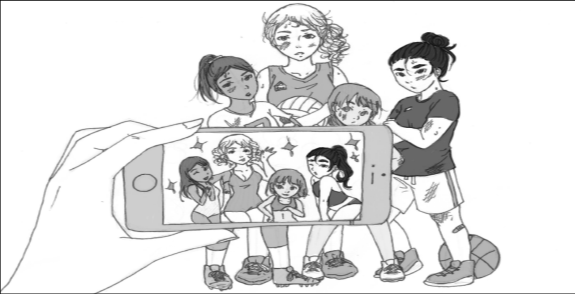
Illustration by Alysse Stephens
I felt my heart thumping against my chest as I made my final strides towards the tree, which represented the finish line. Being the strong willed and competitive eight-year-old that I was, I challenged the boy who was known for winning all the races during recess.
That week, the majority of my class decided to have a racing tournament, where there would be head-to-head races, and the last man standing would win.
While we were organizing the people who were going to race each other, I heard the boy tell his friend that he was not racing against a girl because it simply “was not fair” for the girl. I immediately called him out, and said, “I think you are just scared to lose to a girl.”
That is how I ended up sprinting for my dignity. I saw the finish line getting closer and closer, and victory! The boy finished just milliseconds after me, and his face was as red as a tomato as his friends taunted him. His response: “I let her win.”
Sports have the opportunity to bring about feminine empowerment and gender equality.
However, women in sports are being chased with the constant shadow of gender-based discrimination fueled by the constant stereotypes of women’s physical ability being less than a man’s.
The media contributes hugely to the stereotypes by the ways it portrays female athletes.
In a Purdue and University of Southern California study, 96.4 percent of the content on “ESPN” was dedicated to male athletes.
Magazines, such as “Sports Illustrated,” portray female athletes on their covers only 13 percent of the time. When women are portrayed on the covers, 10 percent of the women hold no relationship to athletics.
In fact, the “Sports Illustrated” swimsuit issue uses mostly models who are not professional athletes.
“The ‘Sports Illustrated’ swimsuit issue really sets the social standard for what people expect the perfect woman’s body to look like, and a lot of those bodies usually look the same,” said professional wrestler, Ronda Rousey.
When a female athlete is portrayed individually on a cover, most of the time, the picture accentuates the woman’s body, while with pictures of male athletes, their athletic abilities are accentuated.
The media also mainly televises male sports which contributes to the considerable wage gap seen between men and women athletes.
According to Forbes List of the World’s Highest Paid Athletes, tennis player Serena Williams is the only female on that list of 100. Despite winning several championships, and being known internationally, she was only ranked 51st with a salary of $27 million. The highest paid male tennis player is Roger Federer ranked fourth with a salary of $64 million.
Williams is not only the lowest paid tennis player on the list, but also receives less than Andy Murray, Rafael Nadal, Kei Nishikori, and Novak Djokovic.
The highest paid athlete on the list was soccer player Cristiano Ronaldo. He makes $93 million a year. The highest paid male athlete makes 344 times more than the highest paid female athlete.
In 2015, the United States Women’s National Soccer Team won the Women’s World Cup. A little over a year later, in March 2016, some of the women on the team such as Carli Lloyd, Alex Morgan, Megan Rapinoe, and Hope Solo filed a wage discrimination complaint against U.S. Soccer with the U.S. Equal Employment Opportunity Commission.
When the complaint was filed, Time reported that the women were making only 40 percent of what the men were making despite having gained a huge television audience during the 2015 World Cup.
“Simply put, we’re sick of being treated like second-class citizens. It wears on you after a while. And we are done with it,” said U.S. National Team co-captain, Carli Lloyd in a column she wrote for the “New York Times” in April 2016.
As a female athlete, I have witnessed sexism in sports first hand. I have been told that I was not fast enough, strong enough, or tough enough to play at the same level as the boys. While attending basketball games, I see the considerable difference between the hype at the boys’ game and the hype at the girls’ game.
As a culture, we have a duty to empower all people regardless of gender. What we are doing now diminishes and discourages women to chase their aspirations. As a generation, we must work to include and uplift all people when it comes to the image of strong women athletes in society.


Be the first to comment on "Women’s sports are sports too"